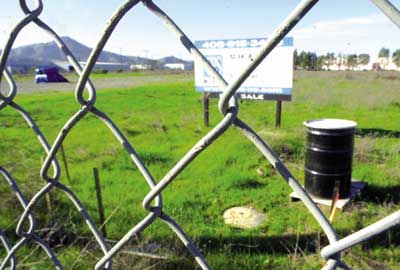A dozen years after authorities discovered a dangerous amount of perchlorate in the groundwater basin and fingered a local company for the widespread contamination, one of the last remaining wells affected is considered safe to drink from.
On Jan. 15, Olin Corporation asked the Central Coast Regional Water Quality Control (CCRWQC) Board staff “to terminate water service (i.e., bottled water) for well users associated with well 09S034J003 (in San Martin),” according to a Feb. 15 letter via the CCRWQC board.
“Olin provided the water board staff analytical results to support the determination that the well meets the State Water Board criteria for termination of bottled water service,” CCRWQC Interim Executive Officer Lisa Horowitz-McCann wrote. “Based on Olin’s submission, we concur that the well meets the State Water Board criteria for termination of bottled water service.”
Semiannual testing for perchlorate will continue at the well located on Seymour Avenue between Maple and East Middle Avenue in San Martin, the letter notes.
Nine households are still receiving bottled water paid for by Olin that would otherwise be served by four existing San Martin wells. These wells are located on Railroad Avenue near Fisher Avenue; along Seymour Avenue; and near the intersection of Seymour and Middle avenues. The perchlorate concentration in one of those wells has dropped below the Maximum Contaminant Level (for three of the households). But four calendar quarters of confirmation sampling have not been completed yet for that well, according to Dean Thomas, an engineering geologist for the CCRWQC Board.
“The majority of the area of concern that was tarnished by Olin operations there in Morgan Hill has been cleaned up,” said San Martin resident Bob Cerruti, chair of the local Perchlorate Community Advisory Group that meets twice yearly to get updates on the site cleanup program from the regional board in San Luis Obispo.
Despite the steady progress made by the cleanup effort, Cerruti said it is expected to last another 25 to 30 years according to projections.
“They are keeping Olin’s feet to the fire and Olin has been cooperative and working well with everybody,” added Cerruti, a member of the oversight group since its inception in 2003. His own drinking water was contaminated and he was using bottled water paid for by Olin until it became safe. “The cleanup in place has helped immensely as well as the previous non-drought years.”
Six households and one business are served by four wells in San Martin equipped with ion exchange treatment units that remove dangerous chemicals from the groundwater, while seven other wells have perchlorate above the federal drinking water standard of six parts per billion. The business is located on Railroad Avenue near Fisher. Those seven wells serve 12 households and one business, Thomas added.
“We work with the Santa Clara Valley Water District to obtain information on new wells drilled in the vicinity of the (perchlorate) plume, and ask new well owners whether they would like Olin to sample their wells for perchlorate,” Thomas said. “If results are above the drinking water standard, the well/households become part of the replacement water program.”
Those wells must be located between Tennant and Middle avenues, approximately one mile maximum from the contamination site, Thomas noted.
In 2003, authorities discovered a massive plume of perchlorate in the groundwater basin emanating from a road flares factory owned and operated by Olin Corporation on Tennant Avenue, to areas throughout south Morgan Hill and San Martin. Authorities think the perchlorate leached into the groundwater from Olin’s facility for more than 40 years, starting in the 1960s when the factory opened.
Perchlorate occurs naturally, but it can be harmful to humans—especially children and pregnant women—if consumed in higher-than-background quantities.
Olin has been held accountable for the contamination and forced by environmental regulators to clean the chemical out of the groundwater. The corporation has also been required to provide bottled “replacement water” to residents with highly contaminated wells ever since the contamination was discovered, and until the groundwater can be cleaned of the chemical.
In 2004, as many as 188 households hooked up to residential wells in the south Morgan Hill and San Martin areas were receiving bottled water due to the contamination, according to Thomas’ report.








